129 - Art and Angels - Feeding the Soul
Thursday, December 18, 2014
What role does art play in the world? Is it just a middle-class indulgence? Or is it something more fundamental that feeds the soul in just as important a way as food for the stomach?
Artists deserve to eat too. I don't know any rich artists. OK they may not all be rooting through dustbins to find food, but most are barely scraping a living, and often working in low-paid part-time jobs to ensure some regular income. I would rather help them to enrich my life with a pretty, calming patio or a vibrant painting on my wall, than feed the pockets of the shareholders of Tesco, Amazon, Costa Coffee or MacDonalds. And if it's an indulgence? Well, some will always say it is. But we don't live by bread alone. Everyone should have an occasional treat.
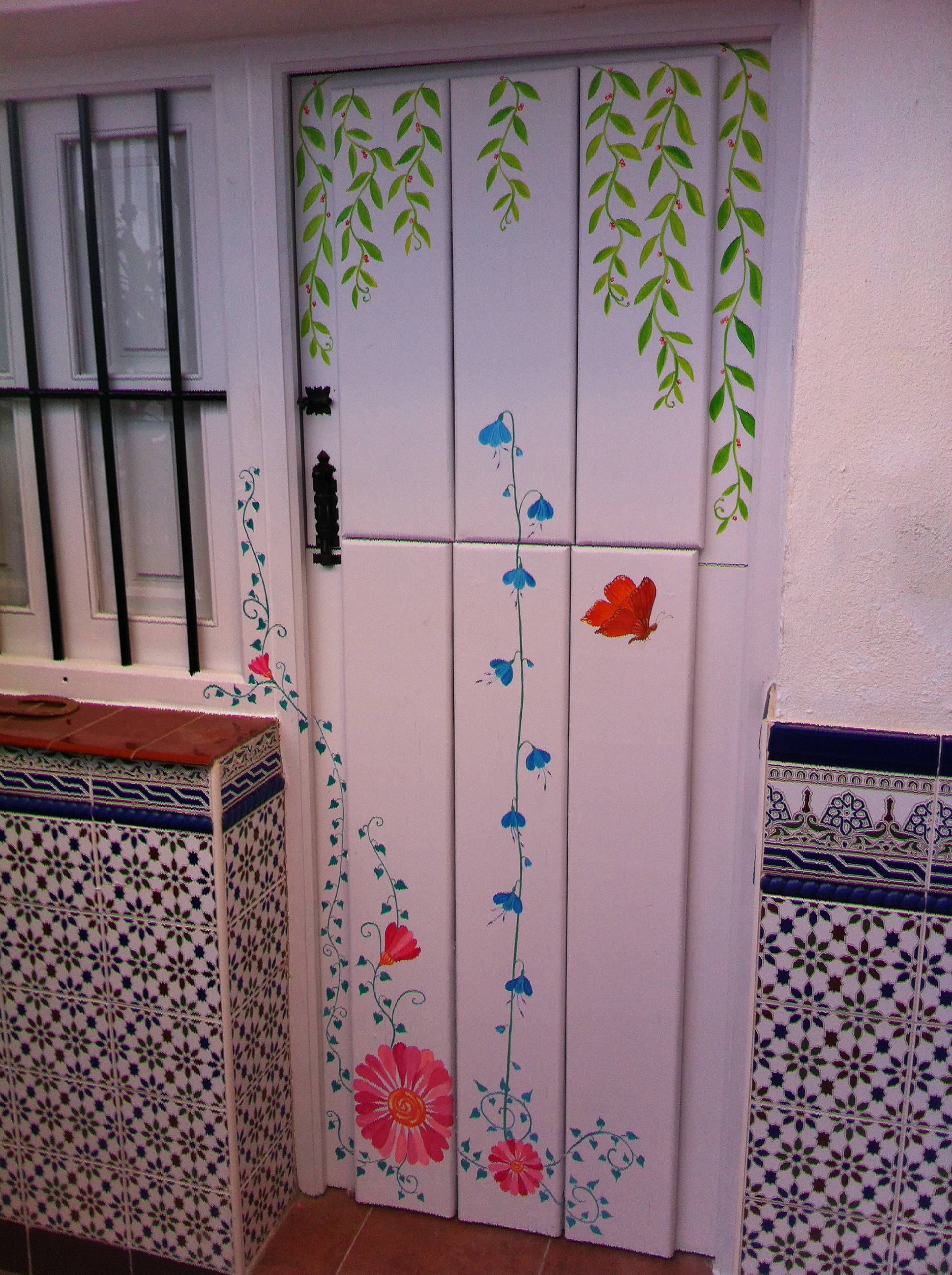 So this summer Su painted the shed doors on my patio. She "sold" me a few days of her time and her talent, but what I bought from her is so much more - the patio became a quiet, pretty spot, bright with colour, a place to relax, a place to write, with flowers and butterflies to make it special. It is a treat whenever I sit there on the sofa, hand-made mosaics on driftwood above me, and Ann's little pottery doves on the shelf. Art is all around me, enriching my home. So this summer Su painted the shed doors on my patio. She "sold" me a few days of her time and her talent, but what I bought from her is so much more - the patio became a quiet, pretty spot, bright with colour, a place to relax, a place to write, with flowers and butterflies to make it special. It is a treat whenever I sit there on the sofa, hand-made mosaics on driftwood above me, and Ann's little pottery doves on the shelf. Art is all around me, enriching my home.
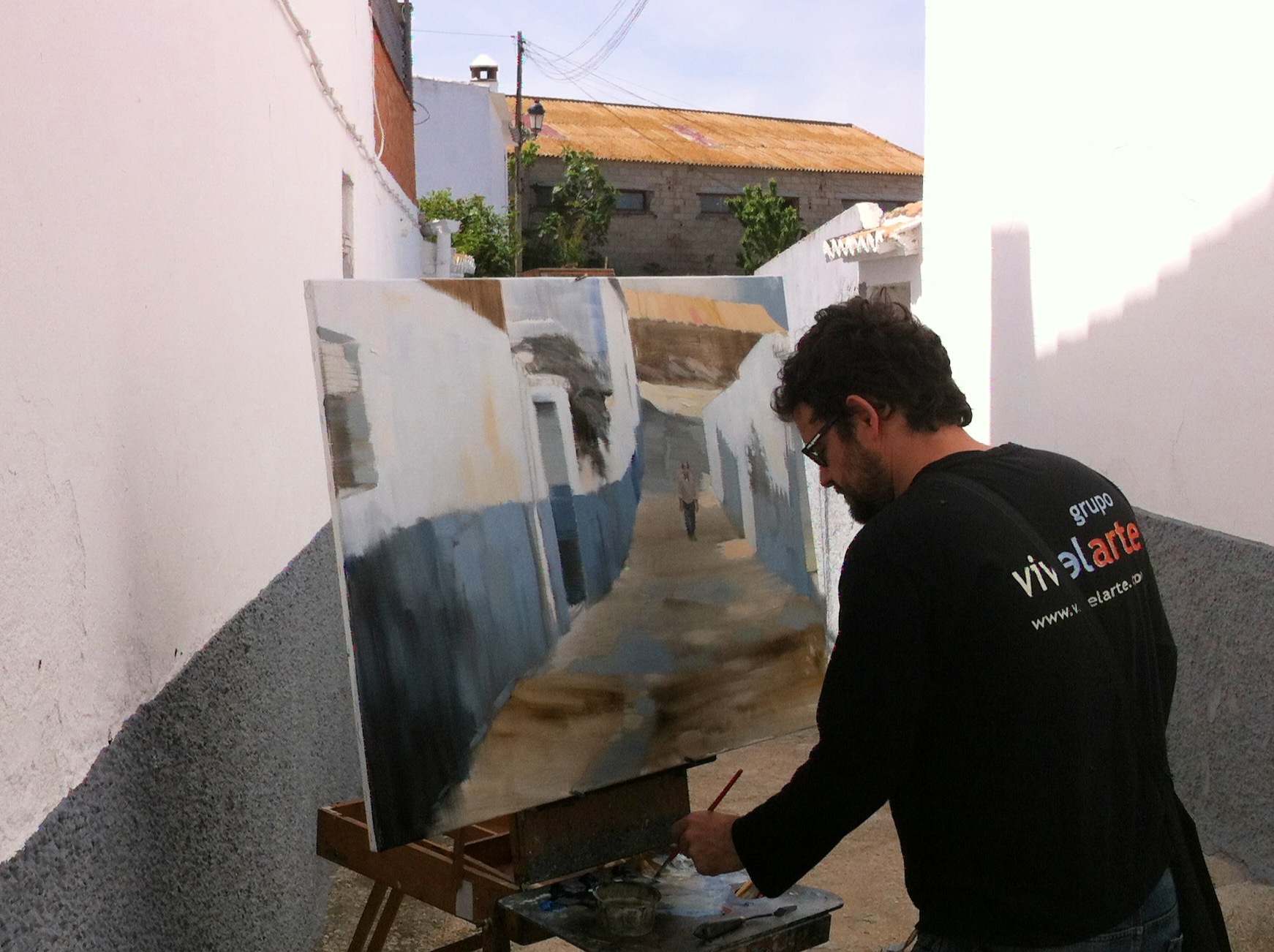 In the spring I had bought a watercolour of Colmenar on the "pintura rapida" day in May, and fell in love with Miguel's paintings. His exhibition in a central-Málaga gallery was a success last month and last week I went to his workshop and art school to choose a painting. It was a gift to myself for working hard preparing for the Spanish exam. In the spring I had bought a watercolour of Colmenar on the "pintura rapida" day in May, and fell in love with Miguel's paintings. His exhibition in a central-Málaga gallery was a success last month and last week I went to his workshop and art school to choose a painting. It was a gift to myself for working hard preparing for the Spanish exam.
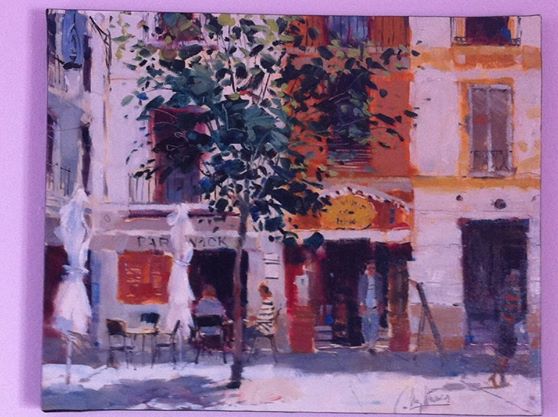
I chose a small oil painting of Plaza de Félix Sáenz. Just as the Colmenar picture "speaks" of the village, this new one "oozes" the spirit of Málaga. It is bright, lively, colourful, and I loved it the moment I saw it. To own it, to have it in my home, is a privilege, and a treat.
Carrying the precious painting back over the footbridge over Málaga's dry riverbed, I passed the graffiti almost without noticing. I'd read it dozens of times, and it had usually made me think. This time, with a newly-mounted and varnished piece of art under my arm, I had to detour to stare at it again. "Se gastan miles de euros en arte ... Y la gente come y muere en la calle." "They spend thousands of euros on art, and the people eat and die in the street." Perhaps the proximity of CAC, el Centro de Arte Contemporaneo, had so angered a homeless or hungry person, he had put the 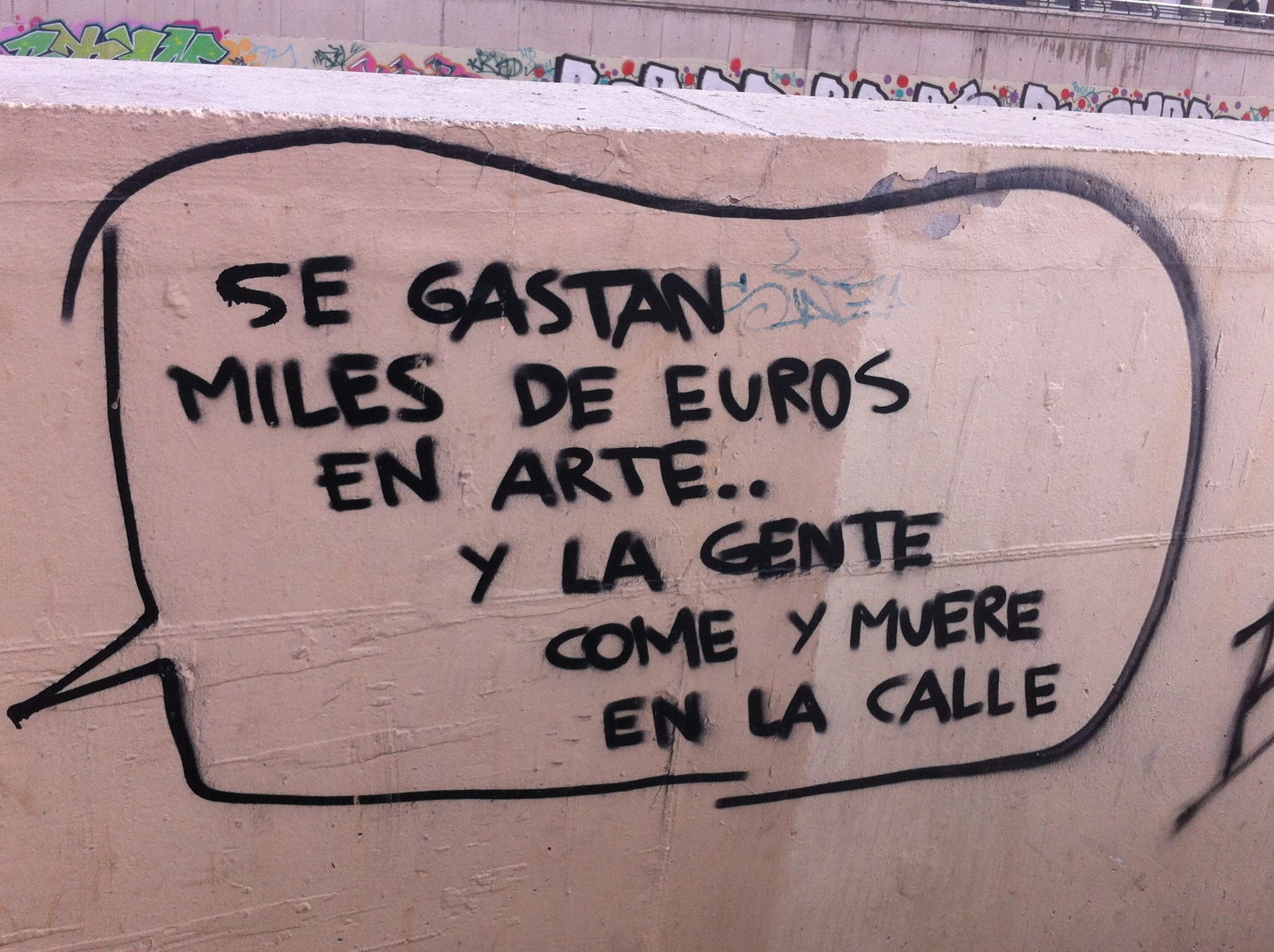 effort into writing this on a wall alongside the dry riverbed. You can argue that there is no connection - in a world without art, probably there would still be people eating and dying in the street. Other people would choose something different about which to rail - "The government spends billions on weapons while people starve on the streets." This sits more comfortably for me, yet is equally false - in a world without war, do I really believe people would not starve? It smacks of the tabloids whipping up simplistic public emotions - "Why build cycle lanes when we need more nurses?" etc etc as though public spending is as straighforward as that. effort into writing this on a wall alongside the dry riverbed. You can argue that there is no connection - in a world without art, probably there would still be people eating and dying in the street. Other people would choose something different about which to rail - "The government spends billions on weapons while people starve on the streets." This sits more comfortably for me, yet is equally false - in a world without war, do I really believe people would not starve? It smacks of the tabloids whipping up simplistic public emotions - "Why build cycle lanes when we need more nurses?" etc etc as though public spending is as straighforward as that.
Well, whatever my own preferences for government budgets, the truth is that in this pedestrianised strip of Málaga, somebody who was presumably largely without resources, chose to create his own corner of graffiti-art complaining 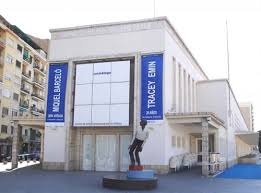 about government spending on art. It is near the contemporary arts centre, true. It is also adjacent to the portakabin of Los Ángeles de la Noche (the Angels of the Night), where the city's most vulnerable people queue for food on a daily basis. I stood for a moment re-reading the spray-painted words of that angry hungry person. The oil painting under my arm represented both an indulgence and a necessity. Is it too idealistic? To want a world where everyone has food, everyone has shelter, everyone has a community to which they belong, and everyone has access to things which feed the soul and uplift the mind? about government spending on art. It is near the contemporary arts centre, true. It is also adjacent to the portakabin of Los Ángeles de la Noche (the Angels of the Night), where the city's most vulnerable people queue for food on a daily basis. I stood for a moment re-reading the spray-painted words of that angry hungry person. The oil painting under my arm represented both an indulgence and a necessity. Is it too idealistic? To want a world where everyone has food, everyone has shelter, everyone has a community to which they belong, and everyone has access to things which feed the soul and uplift the mind?
Federico García Lorca put it perfectly when he said: "Not by bread alone does man live. Were I hungry and helpless in the street I would not ask for a loaf; but for half a loaf and a book." Easy to say, of course, when you are not starving. But he goes on: "I have much more sorrow for a man who wants to know, and can not, than for a hungry man. For a hungry man can easily satisfy their hunger with a piece of bread or some fruit, but a man who has a thirst for knowledge and no means to quench it suffers terrible agony because there are books, books, many books that he needs, and where are those books?"
Back at the car, I carefully tucked the painting safely on the back seat. In the footwell was a carrier bag of six bars of turrón and six bags of biscuits. Nudged by the memory of the grafitti, I walked back to the portakabin and handed it in, receiving a big smile from Belén, the permanently-happy volunteer who looks after the store-cupboard. Later, hanging the painting on the wall, I admire Miguel's skill, I take pleasure in having it on my wall, and now it also has an unbreakable connection to Los Ángeles de la Noche, who meet the most basic needs of the people of Málaga who have the least.
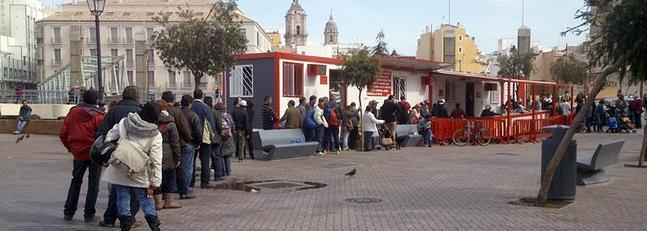 On my Friday morning shift at the portakabin, we make the usual mountain of bocadillos (sandwiches) to hand out with cups of hot soup. Afterwards, as a bonus, there are fingers of rich turrón with nuts. The volunteers know which women have children in a hostel room, and they slip a bag of biscuits into their bags as they collect their soup. Everyone should have an occasional treat. On my Friday morning shift at the portakabin, we make the usual mountain of bocadillos (sandwiches) to hand out with cups of hot soup. Afterwards, as a bonus, there are fingers of rich turrón with nuts. The volunteers know which women have children in a hostel room, and they slip a bag of biscuits into their bags as they collect their soup. Everyone should have an occasional treat.
© Tamara Essex 2014 http://www.twocampos.com
The Artists and the Angels:
Su Derrick painted the patio doors.
She can be reached by email - studio.20lavaqueria@hotmail.com
Website -.www.la-vaqueria.com Facebook - La Vaqueria Benamargosa
Miguel Linares Rios painted the watercolour of the Colmenar street, and the oil painting of the plaza in Málaga. He can be reached via his Facebook page - https://www.facebook.com/mlinaresrios.art
Most of his works are displayed on his Facebook page, and his art school / studio can be visited by appointment by serious buyers.
The Lorca text is from "Medio Pan y Un Libro", a speech he gave when opening the new library in his home town in Granada province full text here:- http://bit.ly/1z0cl5w
Los Ángeles de la Noche feed the city's homeless and hungry people twice a day, every day of the year. They are currently raising funds to enable people to collect a roast chicken from any of thirty rotisserie shops during the Christmas and New Year period. A 6€ donation buys a chicken and potatoes, and can be made by bank transfer to 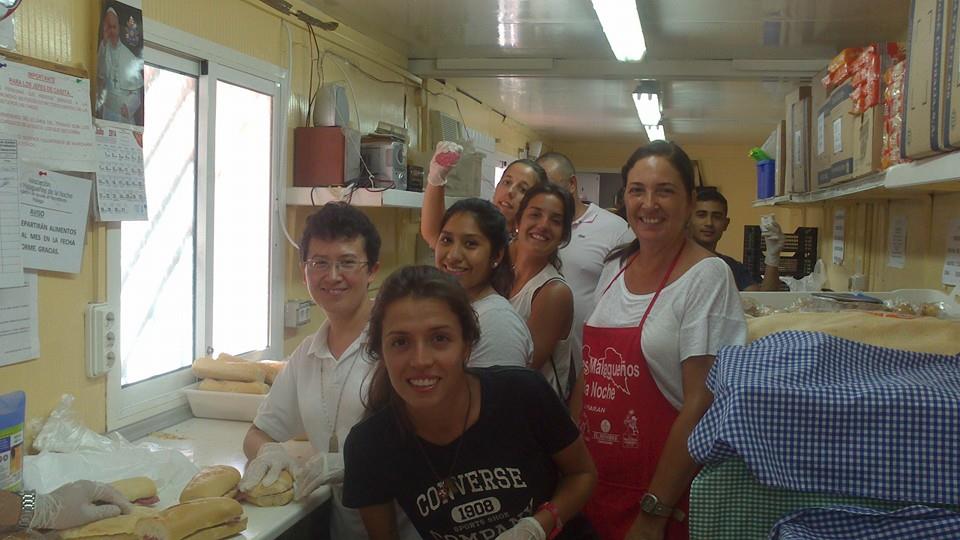 Los Angeles de la Noche (a fully-registered charity) at ......... UNICAJA 2103/ 3034/ 41/ 0010031355 All year round, people near Málaga can pop into Supermercado Preba, C/ Fernan Gonzalez #4 (near the German footbridge over the dry ricer bed), make a donation and receive a receipt. Los Angeles de la Noche (a fully-registered charity) at ......... UNICAJA 2103/ 3034/ 41/ 0010031355 All year round, people near Málaga can pop into Supermercado Preba, C/ Fernan Gonzalez #4 (near the German footbridge over the dry ricer bed), make a donation and receive a receipt.
Facebook page: https://www.facebook.com/losangelesdelanoche/timeline
 0
Like
Published at 5:16 PM Comments (0)
0
Like
Published at 5:16 PM Comments (0)
128 - THAT Time of Year
Thursday, December 11, 2014
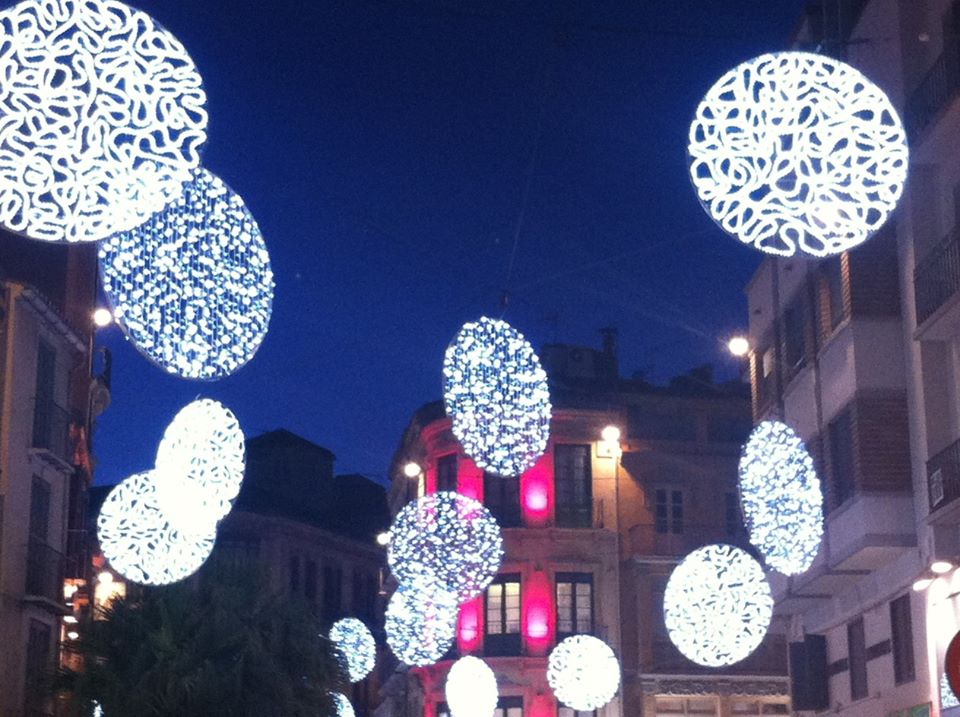 There's never enough time in December. It's as though the whole month is given over to preparing for Christmas, cooking for Christmas, shopping for Christmas, pre-Christmas gatherings, visiting Christmas lights, visiting Christmas nativity scenes, and generally focussing around Christmas. There's never enough time in December. It's as though the whole month is given over to preparing for Christmas, cooking for Christmas, shopping for Christmas, pre-Christmas gatherings, visiting Christmas lights, visiting Christmas nativity scenes, and generally focussing around Christmas.
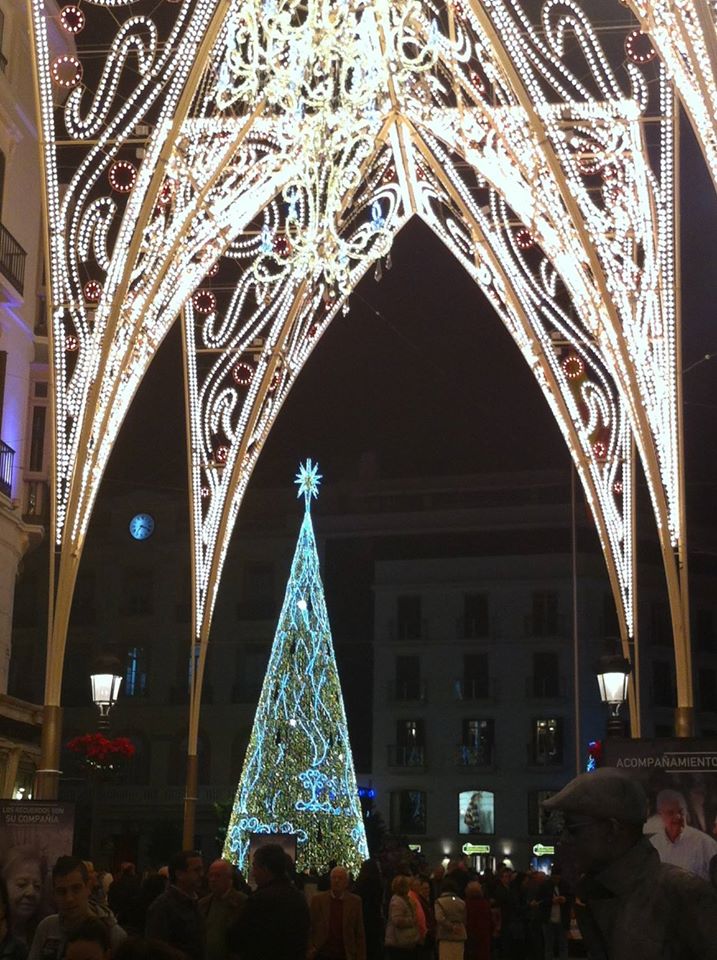 As in previous years, touring the belenes (nativity scenes) and Málaga's Christmas lights takes more than one trip. Although the lights in Calle Larios and la Plaza de la Constitución are always spectacular, we were especially lucky this year to have the incredible "cathedral"-style display, direct from Puente Genil (a town in the province of Córdoba whose lights always punch well above their weight due to the fact that Spain's leading manufacturer of display lighting, los Hermanos Ximenez, is a local family firm). This display had been designed for their home town earlier in the year, where it was especially grand as it celebrated the 125th anniversary of Puente Genil being Spain's first town to have electric lighting. As in previous years, touring the belenes (nativity scenes) and Málaga's Christmas lights takes more than one trip. Although the lights in Calle Larios and la Plaza de la Constitución are always spectacular, we were especially lucky this year to have the incredible "cathedral"-style display, direct from Puente Genil (a town in the province of Córdoba whose lights always punch well above their weight due to the fact that Spain's leading manufacturer of display lighting, los Hermanos Ximenez, is a local family firm). This display had been designed for their home town earlier in the year, where it was especially grand as it celebrated the 125th anniversary of Puente Genil being Spain's first town to have electric lighting.
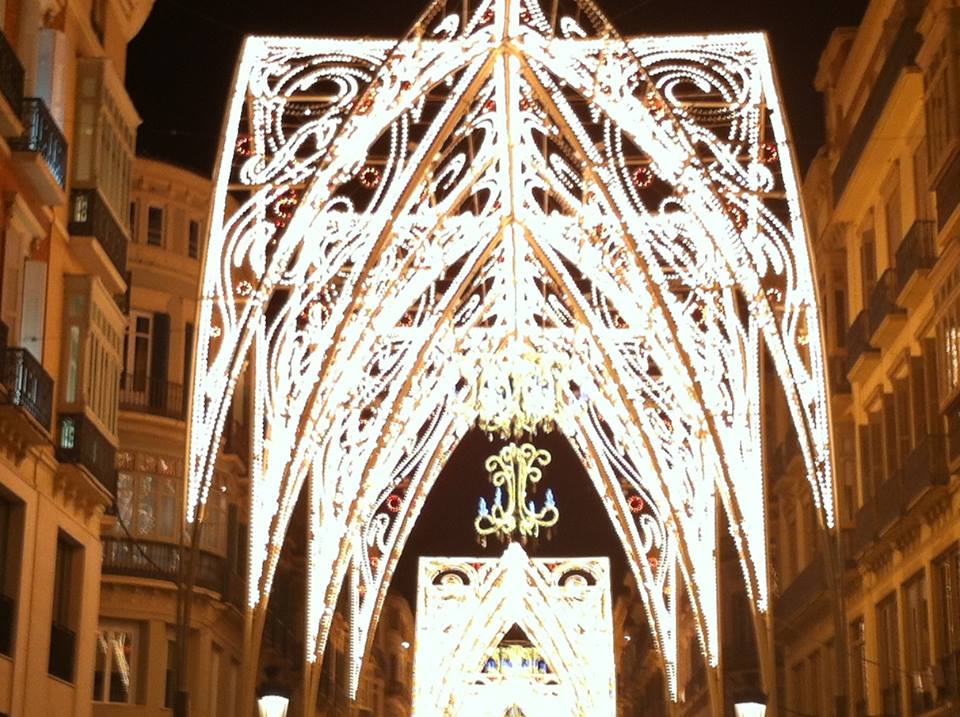 And here it was in Málaga, an extraordinary tunnel of lights reaching down Calle Larios, even more beautiful than ever. The street packed with visitors marvelling at the display. Shops and restaurants full, the crisis temporarily set aside. And here it was in Málaga, an extraordinary tunnel of lights reaching down Calle Larios, even more beautiful than ever. The street packed with visitors marvelling at the display. Shops and restaurants full, the crisis temporarily set aside.
Then over that long holiday weekend between December 6th (el Día de la Constitución) and December 8th (el Día de la Inmaculada Concepción de Maria), in Spanish homes the tree is put up and decorated, and in the villages, towns and cities 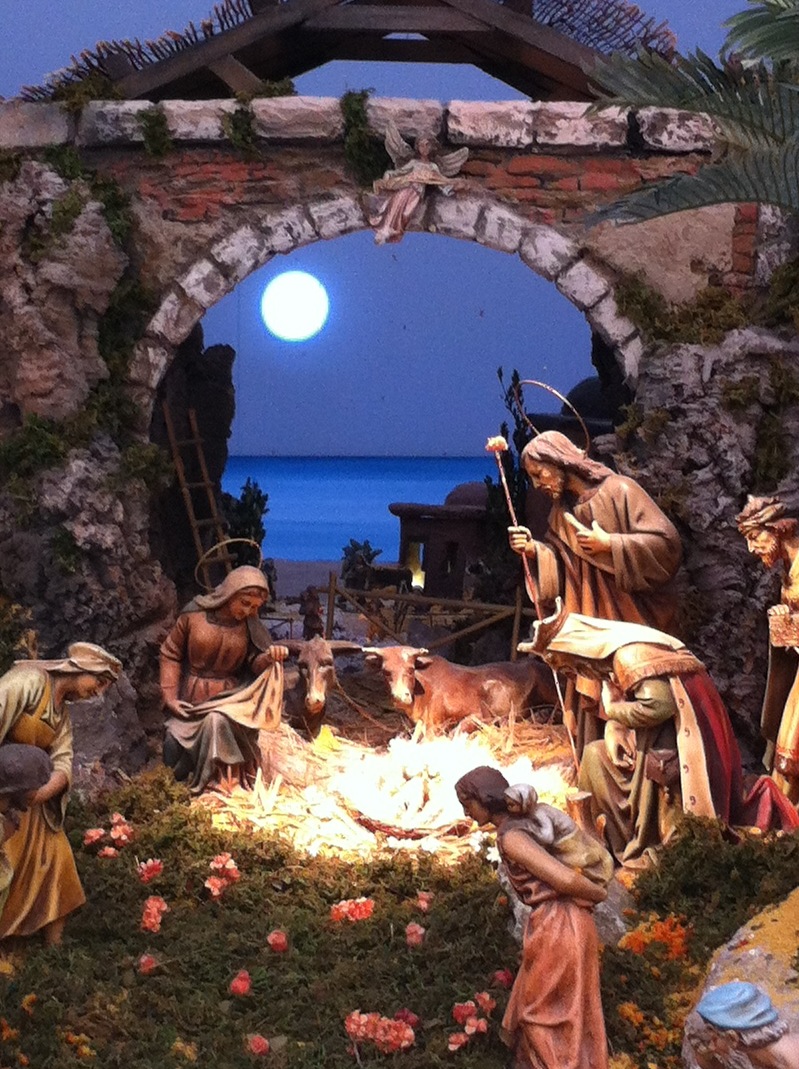 the nativity scenes appear. Not individual little crib scenes, although these of course appear in the windows of houses. No, these belenes are huge great things, many metres long, representing the entire story of the birth of Christ, from the arrival of the Angel Gabriel to tell Mary of her pregnancy, through the journey on a donkey to Bethlehem, the shepherds, the birth, and the Wise Men. Sometimes an entire miniature village is built, often with running water, sun and moon coming out alternately, moving parts, changing lighting - it presents itself as very humble but personally I suspect there is a healthy degree of competitiveness in the building of the belén! the nativity scenes appear. Not individual little crib scenes, although these of course appear in the windows of houses. No, these belenes are huge great things, many metres long, representing the entire story of the birth of Christ, from the arrival of the Angel Gabriel to tell Mary of her pregnancy, through the journey on a donkey to Bethlehem, the shepherds, the birth, and the Wise Men. Sometimes an entire miniature village is built, often with running water, sun and moon coming out alternately, moving parts, changing lighting - it presents itself as very humble but personally I suspect there is a healthy degree of competitiveness in the building of the belén!
Safe winners every year (if there WERE a competition!), hands down, would be El Belén del Barrio de La Mosca. This little community in north-east Málaga created their first belén 23 years ago as part of a protest about a dangerous rock-face above their properties (see Bob Manning's blog for the full story) and it has grown ever since, each household contributing a part, and has become a traditional 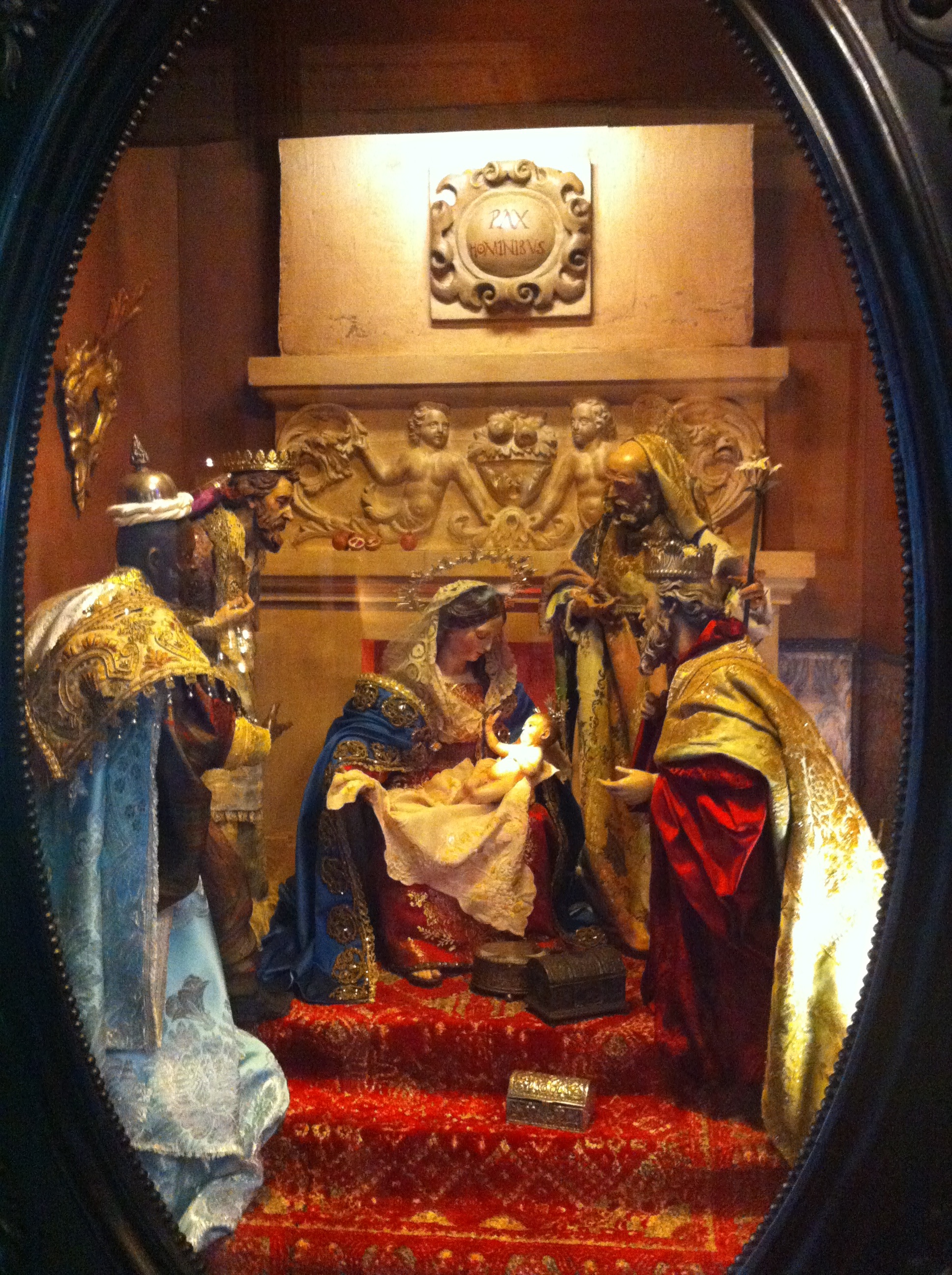 visit for many Malagueñan families every year. Find it in Calle Escritor Manuel Solano. visit for many Malagueñan families every year. Find it in Calle Escritor Manuel Solano.
Apart from La Mosca and the big municipal belén in Málaga's town hall (ayuntamiento), my two favourites this year were a beautiful baroque belén in Cafetería La Puerta Oscura in Calle Molina Larios #5, and the belén made up of over 100 delicate old Lladró porcelain pieces in El Museo de Vidrio y Cristal.
December brought an extra excitement to Colmenar this year, with the arrival of TV cameras 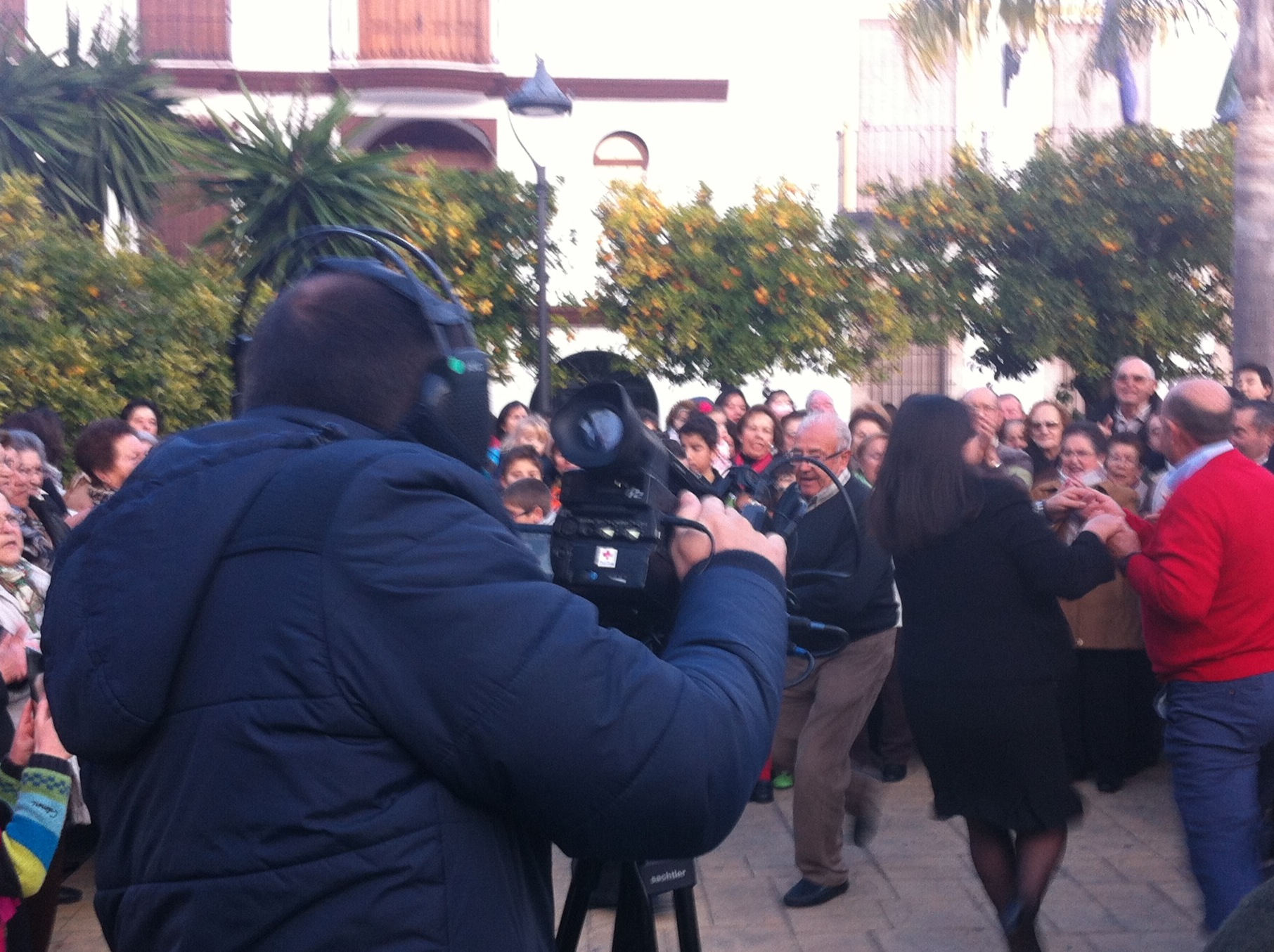 from Canal Sur, and the famous presenter Rafael Cremades for two days filming for "Este es Mi Pueblo" (This is My Town), to be broadcast across Andalucía on December 28th. They filmed in the flamenco club, in a few private houses, in the streets, in the honey museum, and of course in the plaza outside the town hall. For the finale of the show, the townspeople gathered in the square to sing traditional songs and to dance for the cameras, children hitting tambourines and elders hitting zambombas. from Canal Sur, and the famous presenter Rafael Cremades for two days filming for "Este es Mi Pueblo" (This is My Town), to be broadcast across Andalucía on December 28th. They filmed in the flamenco club, in a few private houses, in the streets, in the honey museum, and of course in the plaza outside the town hall. For the finale of the show, the townspeople gathered in the square to sing traditional songs and to dance for the cameras, children hitting tambourines and elders hitting zambombas.
The two little girls next door knocked to ask me politely when Santa would appear climbing his rope up to my balcony. Not for another week, I told them, trying to remember where I had stored him after last year. Before that, my top priority is to give in and buy that most Spanish of items, a brasero (a small circular fire, now usually electric though many households still use the traditional charcoal-burner, that sits under the dining table, all gaps blocked by an enormous chenille tablecloth that reaches the ground). I have sat many a time at my neighbour's kitchen table, legs cosy tucked beneath the heavy tablecloth, but I must admit I have always considered them somewhat dangerous. But needs must, and if the dining table is to be used at all over Christmas then a brasero is needed.
If no blog post appears next week, send the Fire Brigade!
© Tamara Essex 2014 http://www.twocampos.com
THIS WEEK'S LANGUAGE POINT:
Through chatting in Spanish on Facebook I've been picking up more of the written shortcuts that are used, such as xk or xq for "por qué?" or "porque" (why?" and "because"), and xo for "pero" (but). xo needs to be used carefully, because x o x o means "besos y 'brazos" or hugs & kisses. xa means "para" (for) and not surprisingly pf means "por favor".
"Es que" (It's that ....") gets abbreviated and run together to become "Esk".
So I'm getting to grips with reading Facebook posts along the lines of "Buenas, chic@s! Esk me voy xa ver laluz, no? Vengaaa xk es una pura maravilla xo no el viernes x la tarde pf x o x o"
 0
Like
Published at 9:53 AM Comments (0)
0
Like
Published at 9:53 AM Comments (0)
127 - After the Exam
Thursday, December 4, 2014
Mostly, the whole experience of doing exams is almost forty years behind me. And the Spanish GCSE, taken in 2011 at Poole Adult Education Centre, was a walk in the park. But this DELE Spanish exam is no joke. It's the internationally accepted standard, so they have to be rigorous. I wrote last week about the oral exam in "Testing Times". Two days later we all returned to Málaca Institute for the main ordeal, three more exams - reading comprehension, listening comprehension, and writing.
About 70 students gathered in the dining hall. The co-ordinator slowly and clearly explained what would happen during the morning. There were students taking exams at all six levels of DELE. First, the two nervous-looking 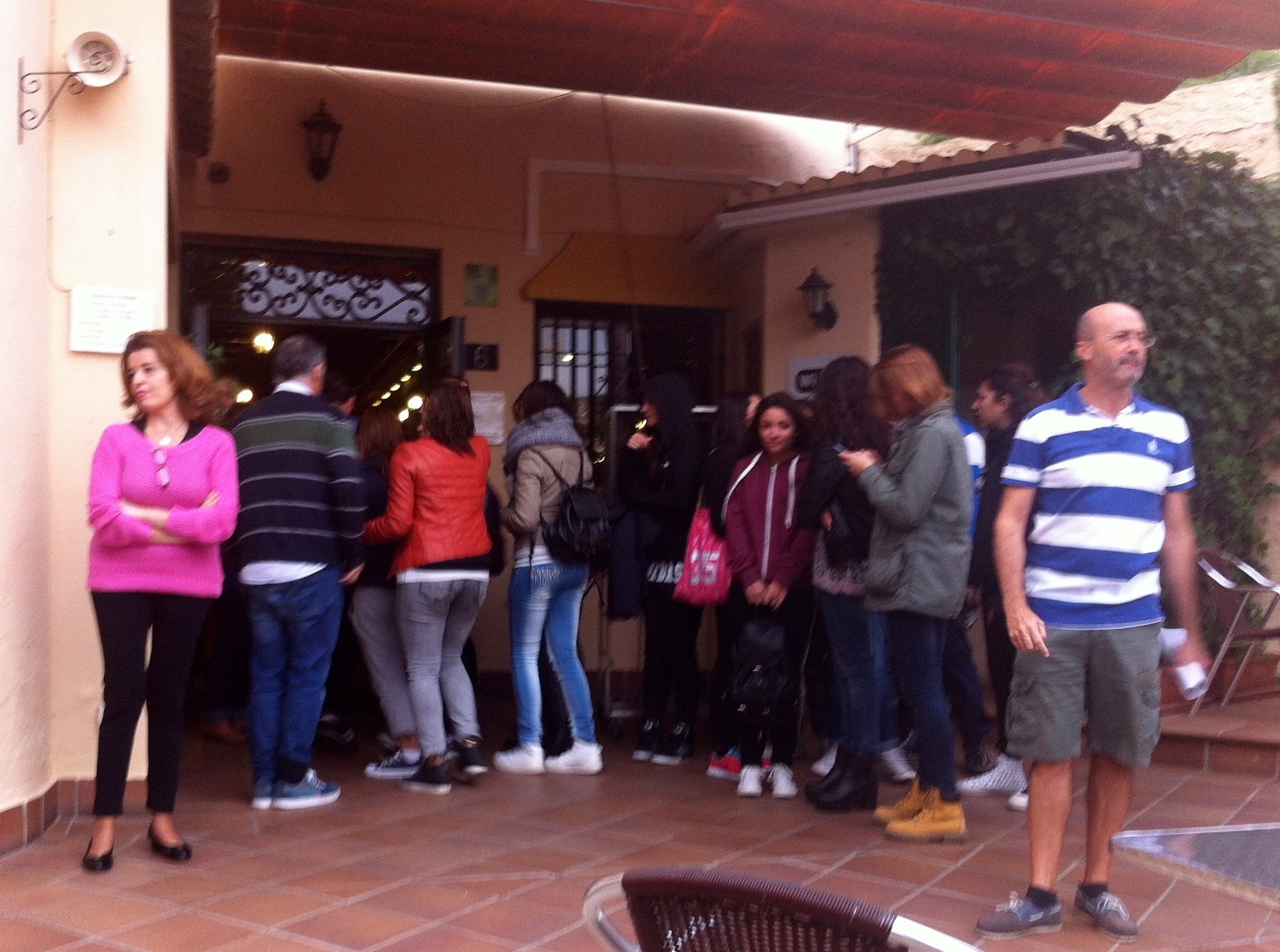 Japanese girls were taken off to a small classroom to do the introductory level, A1. Seven filed off to another room to do A2. He skipped us B1 people as we were the largest group. One lone and brainy-looking student was called up to do the highest possible level, C2, and we applauded him as he was led out. Four more to do C1, so we clapped them too. That left us B-level folks. B2, ahead of us, and about 20 went off, accompanied by cries of "¡Suerte!" That left slightly over thirty to do B1, and we filed down to queue outside the biggest classroom downstairs. Our names were called at the door, and each student sent to a pre-assigned desk. Passports checked again, so that we weren't sending a substitute Spanish friend on our behalf. Japanese girls were taken off to a small classroom to do the introductory level, A1. Seven filed off to another room to do A2. He skipped us B1 people as we were the largest group. One lone and brainy-looking student was called up to do the highest possible level, C2, and we applauded him as he was led out. Four more to do C1, so we clapped them too. That left us B-level folks. B2, ahead of us, and about 20 went off, accompanied by cries of "¡Suerte!" That left slightly over thirty to do B1, and we filed down to queue outside the biggest classroom downstairs. Our names were called at the door, and each student sent to a pre-assigned desk. Passports checked again, so that we weren't sending a substitute Spanish friend on our behalf.
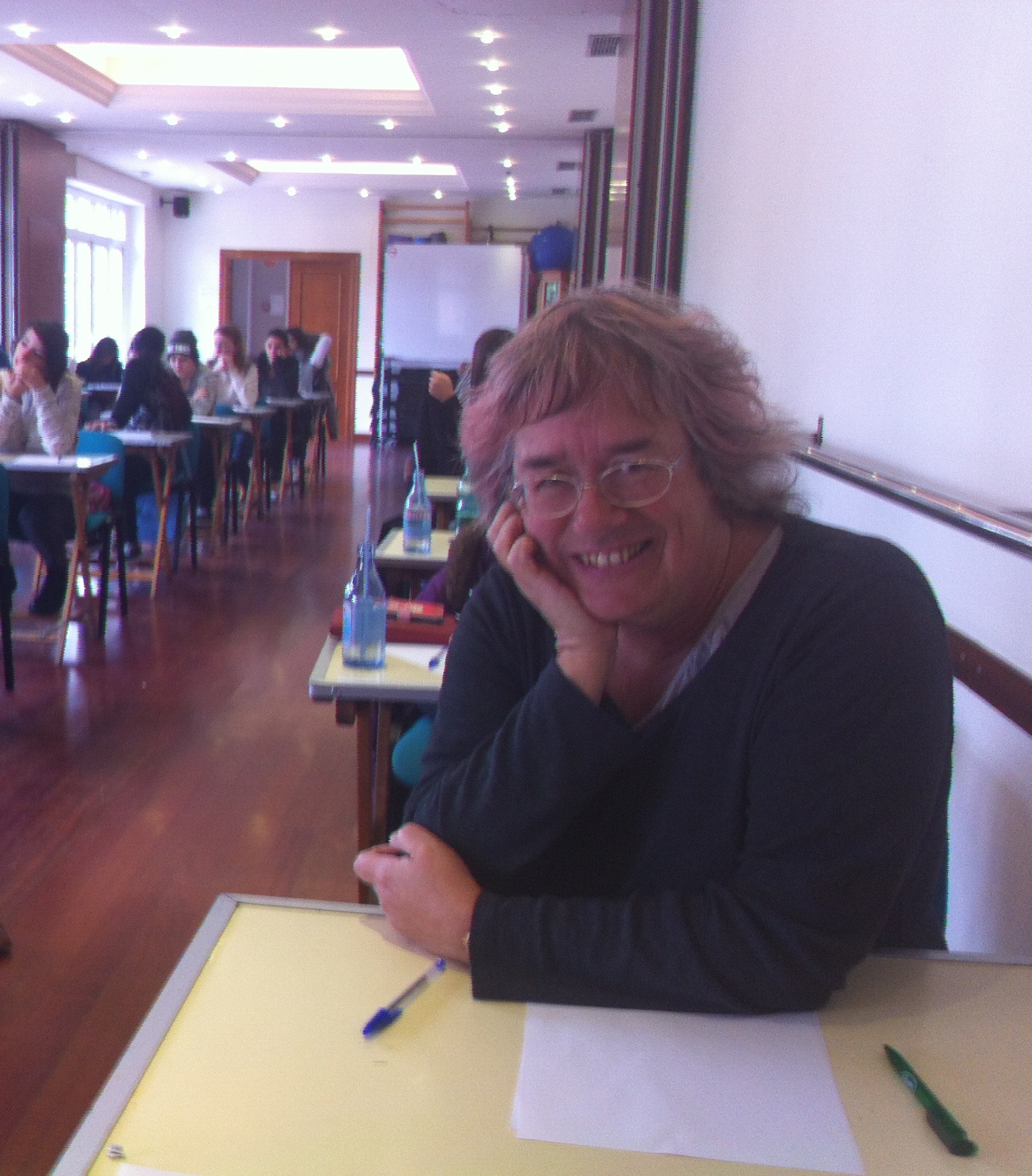 Strict exam conditions. Nothing on the desk except a pencil and a biro. No drinks allowed, except bottled water to be kept on the floor. Final explanations given. Registration data confirmed, name and exam number. Papers distributed, and response papers pre-printed with our names. The clock ticked round. "Gira el papel" - turn your papers over (I remember that from 40 years ago!). Strict exam conditions. Nothing on the desk except a pencil and a biro. No drinks allowed, except bottled water to be kept on the floor. Final explanations given. Registration data confirmed, name and exam number. Papers distributed, and response papers pre-printed with our names. The clock ticked round. "Gira el papel" - turn your papers over (I remember that from 40 years ago!).
It's comprehension. Five tasks. First, read 6 people's description of what they want to do on vacation, read ten adverts for holidays, and match them. Not bad (an obvious trap was easy to spot). Second, read a fairly complex text about the history of a radio station in Peru, and answer six questions. OK. Next read some radio announcements and answer questions on each one. Fine I think. Then read a difficult text about management styles in the workplace, with gaps, read ten text fragments, and choose six to fit into the gaps. Tough. Finally read a text with some prepositions missing (oh lord) and put the right one in. Evil. Seventy minutes whizz by, but there's time to finish and to transfer the answers from the rough paper onto the response sheet.
No break, other than a minute to stand up and stretch. Straight onto the listening. The part everyone dreads. Radio news items, fast but clear, and six questions. An interview with a restaurant owner / critic and some questions about what he says. Then a chat between two young Spaniards, unhelpfully recorded in a noisy street, with traffic noise drowning their words. I know I got at least one wrong, couldn't catch it on the first or second time of listening.
At last a break, for coffee and exchanging views on the dreadful listening exercises. Ah, it turns out that most people thought that Alejandro HAD said he'd been angry with Manolo in the street conversation. That's another point dropped. Then it was on to writing. A "blog post" about an object we remember from our childhood, and a long chatty reply to an email. An hour to make some rough notes then transfer them onto the official answer sheets. Not too bad. And then the exam is over. Daunting, challenging, exhilarating, and - yes - fun! I’d highly recommend the whole process to anyone serious about their language learning.
 The three month wait for the results feels cruel. But people all over the world were sitting the identical exam on the same day, and the marking has to be done, sampled, and then evaluated for even-handedness across all the participants. However, I set aside all thoughts of the exam, packed a bag and headed to Málaga airport for a fiendishly early morning flight to the UK for a week of visiting friends. The three month wait for the results feels cruel. But people all over the world were sitting the identical exam on the same day, and the marking has to be done, sampled, and then evaluated for even-handedness across all the participants. However, I set aside all thoughts of the exam, packed a bag and headed to Málaga airport for a fiendishly early morning flight to the UK for a week of visiting friends.
A foot in two campos. Best of both worlds. Returning to Shaftesbury as it gears up 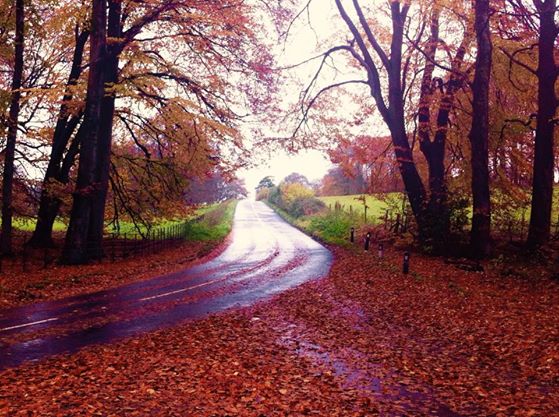 for Christmas. Walks in the stunning Dorset countryside. A brief visit to a Town Council meeting to express disappointment in the overturning of a public consultation. Lunch with Zara at Turnbulls Cafe and Delicatessen, dinner with chums, a day out with Jo (a friend for over half a century) at the Christmas Market by Winchester cathedral. A flying visit to London to see an aunt and uncle (along with some reminiscing, and a look at some fascinating old family papers found in the loft). Staying a couple of relaxing nights with other friends. Christmas presents distributed and received. for Christmas. Walks in the stunning Dorset countryside. A brief visit to a Town Council meeting to express disappointment in the overturning of a public consultation. Lunch with Zara at Turnbulls Cafe and Delicatessen, dinner with chums, a day out with Jo (a friend for over half a century) at the Christmas Market by Winchester cathedral. A flying visit to London to see an aunt and uncle (along with some reminiscing, and a look at some fascinating old family papers found in the loft). Staying a couple of relaxing nights with other friends. Christmas presents distributed and received.

The exam is over. What next? Do I go on and study for B2? I know it's a big step up, with more complex grammar to study. I don't need to keep measuring my improvement against external standards. But "getting by" has never been good enough. Flying back to Málaga I leaf through some of the papers my uncle had loaned me. I open a British Film Institute book about my dad's work as a TV editor and producer. "Uncompromising in his quest for perfection, he set the highest standards for himself and for his crew. 'That'll do' was a phrase that would get you fired off a Tony Essex production." Hmmm. Looks like I may not have complete freedom of choice in the matter. I guess it's in the genes.
© Tamara Essex 2014 http://www.twocampos.com
THIS WEEK'S LANGUAGE POINT:
I've been noticing something about HOW people speak a learned language. There's a habit amongst some native English-speakers, of speaking Spanish as though they are acting, or "wearing" the Spanish language as some sort of external layer. By "acting", I mean that they appear to be acutely aware of speaking Spanish, and I have noticed this even amongst people with quite good grammar and vocabulary. Also, many folks in Spanish lessons, mid-sentence while speaking Spanish, pause and begin to comment in English about their thought processes. "Oh hang on, I'll get it in a minute" etc. For absolute beginners both these habits are natural, but in my opinion, both function as blocks to improvement.
It seems to me that to let go of the "awareness" and simply speak, even with mistakes, would be a big step towards sounding more fluid and natural. The constant reverting back to English, in lessons or in conversations with Spanish people, in my view subconsciously reinforces that the English language is their default position, and to some degree blocks progression. My teacher confirmed that, for example, my rambling search for the correct subjunctive form of a verb (in the oral exam) was perfectly acceptable because I rambled in Spanish, even though it took me five attempts to find the correct construction! However had I even once slipped in a "oh no, sorry, that's not right" in ENGLISH it would have led to significant points being deducted or straight failure.
 1
Like
Published at 1:02 PM Comments (1)
1
Like
Published at 1:02 PM Comments (1)
Spam post or Abuse? Please let us know
|
|